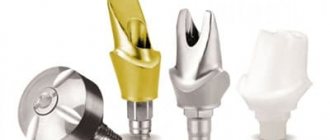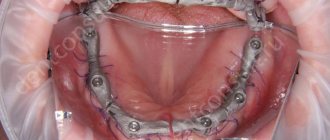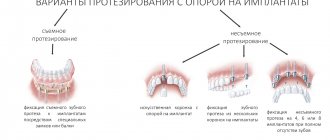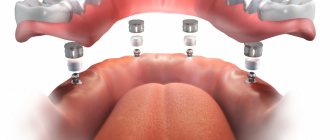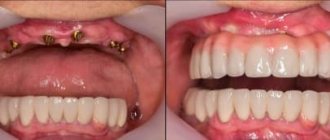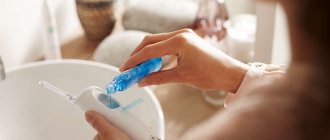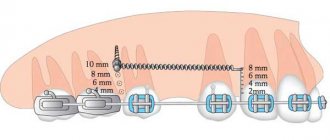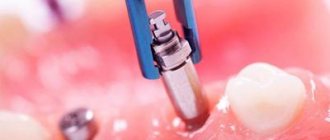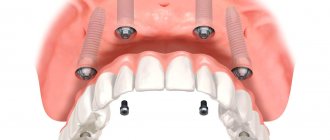But still, proper oral care is 70% of the device’s effectiveness. To keep this 70% intact, you need to follow simple rules regularly. First, be sure to completely remove your dentures before brushing your teeth.
Important! Remove the prosthesis, not the aba, because despite the screw structure, an ordinary person can damage the system when removing it; only a professional can do this. Secondly, use a soft brush and a gentle, non-sanding paste. Thirdly, thoroughly clean the denture itself, and it is advisable to use superfloss and an irrigator. And, of course, monitor the condition of artificial roots regularly! If you follow these simple rules, such a prosthesis will serve you for many years.
Multi-unit abutment
Key component of the All-on-4® treatment concept
Accuracy and ease of use from the developer
In 2000, Nobel Biocare developed the original Multi-unit abutment - at that time the first abutment of its type on the market. Since that time, it has become a recognized industry standard, and many manufacturers have attempted to copy its innovative design. The Multi-unit abutment differs from its analogues in those nuances that determine the success of prosthetics.
The Multi-unit abutment is designed for both full and partial restorations, and in particular for use in combination with the scientifically based and clinically proven All-on-4 ® treatment concept. 1-29
Carefully thought out design
- The short taper is ideal for limited interocclusal distances.
- The wide base of the abutment simplifies the installation of the prosthetic structure.
- For any gum type: straight and angled (17° and 30°) Multi-unit abutments have nine neck heights.
Simplicity and safety of operation
Each Multi-unit abutment comes with a pre-installed holder, making placement much easier. It also serves as a guide when checking the abutment angle.
Precision precision and aesthetics
Exceptionally accurate fit of fixed and semi-removable NobelProcera structures. A wide range of precision milled CAD/CAM designs, each carefully tested for compatibility and accurate fit with the Multi-unit abutment.
Multi-unit Plus Abutment
The Multi-unit Plus abutment for tapered implants takes the All-on-4 ® protocol to the next level. The Multi-unit Plus abutment is designed to significantly simplify and speed up temporary restorations.
Simplification of the temporary prosthetic protocol
The Temporary Snap Coping easily snaps onto the Multi-unit Plus Abutment and does not require the use of screws to secure the temporary restoration during try-in and preparation.
Save time in the clinic and laboratory
The new snap-on feature will help significantly reduce the time it takes to reline an existing prosthesis or create a new temporary structure.
Authenticity matters
A system is only as strong as its weakest link. The effectiveness of each individual component depends not only on its quality and design, but also on its interaction with the rest of the orthopedic system.
That's why we carry out tests and research both on the individual components and their interactions, and on the entire system they form.
Feedback from clinicians
Dr Rob Wain, UK
“I have been using Multi-unit abutments from Nobel Biocare for over ten years. I regularly use them both for All-on-4 ® treatment and for various clinical cases where it is necessary to compensate for the angle of the implant before installing a screw-retained prosthesis.
It is much more comfortable for both me and the patient to work at the soft tissue level, which allows me to perform prosthetics with a greater degree of confidence and safety. The long-term stability and success rates of the structures are excellent, and the easy access makes hygiene and care of the structure easier for the patient.”
Dr. Peter Wöhrle, USA
“The snap-on feature of the Multi-unit Plus abutment makes the integration of temporary copings into the temporary restoration much quicker and easier. This is important because treatment times are reduced, and even dentists with little experience can use this protocol with predictable results.”
Clinical cases
Dr. Paulo Maló, Portugal - All-on-4® Treatment Concept with NobelGuide
Clinical case:
female patient, 50 years old, completely edentulous, removable dentures on the upper and lower jaws installed more than 15 years ago.
Solution:
segmental rehabilitation of the upper jaw using fixed implant-supported structures and the All-on-4 ® treatment concept. The NobelGuide protocol (flapless technique) was used in the upper jaw, and the traditional All-on-4 ® flap technique was used in the lower jaw. High-precision NobelProcera implant-supported bridges were chosen as permanent structures in both the upper and lower jaws.
Dr. Rubén Davó, Spain – Complete rehabilitation for severe atrophy of the upper and lower jaw
Clinical case:
female patient, 60 years old, with severe bone resorption of the upper and lower jaw under a complete removable denture.
Solution:
For rehabilitation of the upper jaw, Brånemark System Zygoma and NobelReplace Tapered implants were used. The All-on-4 ® treatment concept was applied to the lower jaw. NobelProcera high-precision implant-supported bridges were chosen as the permanent structure in both the upper and lower jaws.
Literature
Multi-unit Abutment – Nobel Biocare
1. Malo P, de Araujo Nobre M, Lopes A. The use of computer-guided flapless implant surgery and four implants placed in immediate function to support a fixed denture: preliminary results after a mean follow-up period of thirteen months. J Prosthet Dent 2007;97(6 Suppl):26-34
2. Aparicio C, Perales, P, Rangert, B Tilted implants as an alternative to maxillary sinus grafting: a clinical, radiologic, and periotest study. Clin Implant Dent Related Res 2001; 3:39–49.
3. Abi Nader S, Eimar H, Momani, M. Plaque Accumulation Beneath Maxillary All-on-4 Implant-Supported Prostheses. Clin Implant Dent Relat Res 2014; epub ahead.
4. Agliardi E, Panigatti S, Clericò M, Villa C, Malò P. Immediate rehabilitation of the edentulous jaws with full fixed prostheses supported by four implants: interim results of a single cohort prospective study. Clin Oral Implants Res 2010; 21:459-655.
5. Antoun H, Belmon P, Cherfane P, Sitbon JM. Immediate loading of four or six implants in completely edentulous patients. Int J Periodontics Restorative Dent. 2012; 32(1):1-9.
6. Babbush C, Kutsko G, Brokloff J. The all-on-four immediate function treatment concept with NobelActive implants: a retrospective study. J Oral Implantol 2011;37:431-457.
7. Babbush C, Brokloff, J. A Single-Center Retrospective Analysis of 1001 Consecutively Placed NobelActive Implants. J Implant Dent 2012; 21(1): 28-35.
8. Baggi L, Pastore S, Di Girolamo M, Vairo G. Implant-bone load transfer mechanisms in complete-arch prostheses supported by four implants: A three-dimensional finite element approach, J Prosthet Dent 2013;109(1):9 -21
9. Butura CC, Galindo DF. Combined immediate loading of zygomatic and mandibular implants: a preliminary 2-year report of 19 patients. Int J Oral Maxillofac Implants 2014; 29(1): 22-29.
10. Butura CC, Galindo DF, Jensen OT. Mandibular all-on-four therapy using angled implants: a three-year clinical study of 857 implants in 219 jaws. Oral Maxillofac Surg Clin North Am 2011; 23(2): 289-300.
11. Cavalli N, Barbaro B, Spasari D. Tilted implants for full-arch rehabilitations in completely edentulous maxilla: a retrospective study. Int J Dent; ePub ahead 2012.
12. Francetti L, Agliardi E, Testori T. Immediate rehabilitation of the mandible with fixed full prosthesis supported by axial and tilted implants: interim results of a single cohort prospective study. Clin Implant Dent Relat Res 2008;10(4):255-263.
13. Francetti L, Romeo D, Corbella S, Taschieri S, Del Fabbro, M. Bone Level Changes Around Axial and Tilted Implants in Full-Arch Fixed Immediate Restorations. Interim Results of a Prospective Study. Clin Implant Dent Relat Res 2012; 14( 5):646-654.
14.Galindo DF, Butura CC. Immediately loaded mandibular fixed implant prostheses using the all-on-four protocol: a report of 183 consecutively treated patients with 1 year of function in definitive prostheses. Int J Oral Maxillofac Implants 2012; 27(3):628-633.
15. Gunaseelan R, Saravanakumar M, Hariharan R. Restoration of failing maxillary implant supported fixed prosthesis with cross arch splinted unilateral zygomatic implant: A Clinical Report. J Oral Implantol 2012;38(6):751-755.
16. Landazuri-Del Barrio RA, Cosyn J, De Paula WN, De Bruyn H, Marcantonio Jr E. A prospective study on implants installed with flapless-guided surgery using the all-on-four concept in the mandible. Clin Oral Implants Res 2013;24(4) 428-433.
17. Lopes A, Maló P, de Araújo Nobre M, Sanchez-Fernández E. The NobelGuide® All-on-4® Treatment Concept for Rehabilitation of Edentulous Jaws: A Prospective Report on Medium- and Long-Term Outcomes. Clin Implant Dent Relat Res 2014; 10.1111/cid.12260. .
18. Malo P, de Araujo Nobre M. A new approach for maxilla reconstruction. Eur J Oral Implantol 2009; 2(2):101-114.
19. Malo P, de Araujo Nobre M, Lopes A, Francischone C, Rigolizzo M. “All-on-4” Immediate-Function Concept for Completely Edentulous Maxillae: A Clinical Report on the Medium (3 Years) and Long-Term ( 5 Years) Outcomes. Clin Implant Dent Relat Res 2012;14 Suppl 1:139-150.
20. Malo P, de Araujo Nobre M, Lopes A, Moss SM, Molina GJ. A longitudinal study of the survival of All-on-4 implants in the mandible with up to 10 years of follow-up. J Am Dent Assoc 2011;142(3):310-320.
21. Malo P, de Sousa ST, De Araujo Nobre M. Individual Lithium Disilicate Crowns in a Full-Arch, Implant-Supported Rehabilitation: A Clinical Report. J Prosthodont 2014; ePub ahead.
22. Malo P, Nobre M, Lopes A, Francischone C, Rigolizzo, M. Three-year outcome of a retrospective cohort study on the rehabilitation of completely edentulous atrophic maxillae with immediately loaded extra-maxillary zygomatic implants. Eur J Oral Implantol 2012;5(1):37-46.
23. Malo P, Nobre M, Lopes A. Immediate Rehabilitation of Completely Edentulous Arches with a Four-Implant Prosthesis Concept in Difficult Conditions: An Open Cohort Study with a Mean Follow-up of 2 Years. Int J Oral Maxillofac Implants 2012;27(5):1177-1190.
24. Malo P, Rangert B, Nobre M. All-on-4 immediate-function concept with Branemark System implants for completely edentulous maxillae: a 1-year retrospective clinical study, Clin Implant Dent Relat Res 2005;7(Suppl 1): S88-S94, 2003-161
25. Mozzati M, Arata V, Gallesio G, Mussano F, Carossa S. Immediate Postextractive Dental Implant Placement with Immediate Loading on Four Implants for Mandibular-Full-Arch Rehabilitation: A Retrospective Analysis. Clin Implant Dent Relat Res 2013;15:332-40.
26. Puig CP. A retrospective study of edentulous patients rehabilitated according to the 'all-on-four' or the 'all-on-six' immediate function concept using flapless computer-guided implant surgery. Eur J Oral Implantol 2010;3(2):155-163.
27. Schroering R, Parrish K. Clinical protocol for rapid, graftless, four-implant restoration of the fully edentulous patient. Practical Procedures and Aesthetic Dentistry 2008; 29: supported by Nobel Biocare
28. Van Lierde, KM Browaeys H, Corthals P. Impact of fixed implant prosthetics using the 'all-on-four' treatment concept on speech intelligence, articulation and oromyofunctional behavior. Int J Oral Maxillofac Surg 2012; 41(12):1550–1557.
29. Weinstein R, Agliardi E, Fabbro MD, Romeo D, Francetti L. Immediate rehabilitation of the extremely atrophic mandible with fixed full-prosthesis supported by four implants. Clin Implant Dent Relat Res 2012;14:434-41.
Manufacturers
Two thousand companies produce implants and suprastructures, of which two hundred have their own factories, and only 62 companies have a closed production cycle. These include: Nobel Biocare (Switzerland), Alpha-Bio (Israel), Ankylos (Germany) and Astra Tech (Sweden).
Multi-unit abutments are available for almost all known systems and are a standard solution to non-standard prosthetic problems.
Nobel (Nobel) . The Nobel company produces suprastructures from highly biocompatible materials (titanium, zirconium, gold, and their alloys) using the latest technologies. The difference between Nobel products is super precise fit, excellent cosmetic results.
The innovative design of the original Multi-unit Nobel adapter is the recognized standard for partial and full dentures. Conditionally removable acrylic dentures are manufactured using patented NobelProcera technology based on scanning and 3D modeling. After calculations, we obtain the most accurate titanium frame and a multi-profile connecting element adapted to the patient’s jaw.
Features of abutments made using Nobel Procera technology:
- strength;
- accuracy;
- maintainability;
- aesthetics;
- long-term operation.
Alpha-Bio (Alpha-Bio) . They are made from biocompatible materials, have a practical design, and fit well to the gums. The main difference is a reliable connection and ease of installation. The hexagonal recess inside the metal root fits exactly into the hexagonal cone of the superstructure. A tight fit of the inner wall of the implant to the multiunit abutment is ensured, eliminating gaps and microcracks.
Ankylos (Ankylosis) . A special feature of German Ankylosis abutments is the TissueCare Connection, which moves the transition border closer to the center of the root. This reduces the load and eliminates loosening and breakage of the superstructure.
Ankylos implants are supplied in a sterile flask, each structural element is placed in a sealed package, the set contains a fixing screw and a holder. Ankylosis products are manufactured according to three-dimensional computer modeling. A unified fastening with an implant provides a free combination of orthopedic elements.
Dentium (Dentium) . The South Korean company began manufacturing implants and superstructures in 2000. Advantages of abutments:
- ease of installation;
- tight connection with the implant, eliminating the risk of infection;
- good stabilization due to tight fixation;
- excellent aesthetic indicators;
- time-tested quality.
Astra Tech (Astra Tech) . The Swedish company produces four types of permanent and temporary abutments for different clinical cases.
Features of Astra Tech multi-unit superstructures:
- Precise load distribution with self-centering Conical Seal Design.
- Sterility - Astra Tech implants are stored and transported in vacuum ampoules.
- The cone shape is a reliable insurance against displacements inside the structure.
- The absence of a central screw ensures tightness and prevents bacteria from entering the structure.
- The ability to grind allows you to adjust the size and shape of the structure to fit the jaw bone.
- Universality - thanks to the uniform diameter of the structural elements, each Astra Tech implant fits any Astra Tech abutment.
Dental implantation on multi-units
Implantation on Multi-units is a relatively new implant technology that facilitates and improves the installation of an orthopedic structure on titanium roots. Multi-unit is a multi-component abutment onto which the prosthetic system is fixed with a screw fastening. In contrast to the cement method of attachment, the prosthesis on Multi-units can be easily removed if correction or replacement is needed. Multi Unit prosthetics provide reliable, stable fixation. The depreciation of the prosthesis under chewing load and the risk of penetration of cement under the gums are eliminated.
general characteristics
The MultiUnit abutment was released by the Nobel Biocare brand in 2000 and has not yet lost its popularity. The element is used for fixing single and complete dentures of fixed and conditionally removable types after the implantation procedure.
The company provides a lifetime warranty and free replacement of any component. If the abutment was installed on a prosthetic structure of another brand, the warranty period is ten years.
The prosthetic system formed when using MultiUnit is conditionally removable. If repairs or replacement are necessary, the orthopedic product can be dismantled without the possibility of damage or reducing the stability of the prosthesis.
Popular samples:
- Straight – compensates for the divergence angle of implants up to 40⁰.
- Angular – a similar purpose of use for angles up to 74⁰.
- Angular – covers an angle divergence of less than 100⁰.
The product is designed to facilitate and speed up the procedure for temporary prosthetics. The temporary cap is easily attached to the MultiUnit and does not require screw fixation of the temporary prosthetic structure.
The effectiveness of each MultiUnit structural element depends on quality characteristics, design decisions and interaction with the rest of the system components.
What is Multi Unit
The ROOTT Multi-Unit implant and the Multi-Unit abutment are two different designs.
- Implant Multi-Unit ROOTT
One-piece monoblock implant with a flexible abutment (the root body and adapter form a single system). Such implants are used in one-stage protocols with immediate loading, when restoring a long-term dental defect - in the absence of 3 or more adjacent teeth. The orthopedic system is fixed 2-3 days after implantation of titanium roots. Thanks to the flexible adapter, the doctor adjusts the position of the prosthesis taking into account the characteristics of the patient’s bite and occlusion.
Multi-Unit Abutment
A separate element that is installed on a classic two-component implant after its complete osseointegration. It is used for both single and multiple restorations. Suitable for fixing a single crown or bridge.
Differences
Specialists who have experience working with this category of abutments note a number of positive aspects that distinguish the devices from their analogues:
- Stability of the formed system during All-on-4 prosthetics;
- The ability to combine elements, which increases the efficiency of restoration and eliminates surgical intervention;
- Acceptability of application when implementing one-time protocols;
- Convenience and ease of installation and subsequent interaction with the abutment;
- Minimum likelihood of technical errors.
The only drawback can be considered the cost of manufacturing the structure, which exceeds the cost of creating standard models.
Multi-unit implant system ROOTT
The ROOTT universal implantation system presents a line of one-component multi-unit implants for screw fastening of prosthetic structures.
- COMPRESSIVE M. Single-piece implant with multi-unit, standard diameter. Used for screw fixation of full and partial prosthetic structures.
- COMPRESSIVE MP . A one-piece multi-unit implant for installation in the pterygoid region, avoiding the sinus lift procedure.
- COMPRESSIVE MS . Long, narrow monoblock implant with multi-unit for installation in a narrow alveolar ridge. Used for multiple restorations in the anterior region.
All models of the COMPRESSIVE line with multi-units are characterized by:
- High initial and subsequent stability;
- reliable screw fixation;
- taking impressions at gum level;
- adjustable abutment angle;
- ability to be combined with other multi-unit implants.
Specifications
Some of the distinctive features that set MultiUnit models apart from alternative options include:
- Use of fixation technology on hexagonal-cone elements;
- Availability of a wide range of models with variable parameters;
- The use of an internal hexagon, which increases the accuracy of installation;
- The versatility of the elements, which determines the solution of various problems;
- The presence of a platform switching function that supports aesthetics;
- BioActive surface treatment for biocompatibility;
- Possibility of prosthetics in limited areas of the jaw row;
- Nine versions of cervical element height.
The standard package provided by the manufacturer includes a set of screwdrivers for different models of abutments, a titanium cap, an insert for gum formation, as well as auxiliary elements necessary for the implementation of the prosthetic protocol.
Multiunit abutment
A classic abutment is a transitional element that combines an implant with an orthopedic structure (crown, bridge, complete denture) into a single system. The variability of adapters in shape, angle of inclination, material, manufacturer, installation method allows you to choose a superstructure for any type of prosthetics.
Unlike classic adapters, Multi-unit abutments are a multi-component design, consisting of several parts that are assembled into a single system during installation. Multi-unit abutments have different lengths, inclination angles, projection and neck heights. For ease of installation, systems are used on three orthopedic platforms - standard, wide, narrow. The fixation method is exclusively screw, which makes it possible to disassemble the structure in the future and replace a separate component.
The designs differ from classical analogues:
- short cone - solves the problem of limited interocclusal space;
- different neck height options - straight and angular nodes allow you to choose a model to suit the patient’s gums;
- different orthopedic platforms to simplify the installation process;
- pre-installation holder - acts as a guide when determining the desired angle of inclination.
The multi-unit abutment can be straight (with an inclination angle of up to 40°) and angular (with an inclination angle of up to 74° or up to 100 ⁰), to compensate for the angle of divergence between the axis of the artificial root and the orthopedic structure. The angle of inclination of the cone when fixing the adapter with a crown is from 5° to 35°.
Indications and contraindications
The use of MultiUnit products is indicated for:
- installation of one crown with screw fixation;
- in the absence of several units standing in a row;
- restoration of dentition;
- the need for rapid removal of prostheses installed according to the “All-on-6”, “All-on-4” protocols or structures with a beam fixation system.
Angled models are fixed on pins implanted at a special angle of inclination. The products reliably fix the prosthesis and help restore the integrity of the dental system.
The model cannot be used to cover the divergence angle of artificial units with a value greater than 1000.
Installation process
Abutments are placed after the mucous membranes have healed and the anatomical contour of the gums has formed. Installation sequence:
- attaching and determining the position of the abutment on the implant;
- tightening the screw with an MT/MUR screwdriver;
- removing the holder;
- final tightening of the screw.
The bridge is secured after two weeks.
Advantages
The popularity of the orthopedic system is due to numerous advantages:
- thoughtful design;
- simplicity and ease of installation;
- high connection accuracy;
- preventing dental cement from getting under the gum;
- possibility of dismantling for medical examination and hygiene procedures;
- possibility of choosing the angle of inclination of the abutment;
- selection of the height of the product, taking into account the height of the mucosa in the defect area.
Lifetime
The period of operation is from 5 years and is determined by factors: the condition of the bone and gums, the qualifications of doctors, and the quality of care.
Hygienic care rules:
- Removing the prosthesis before hygiene procedures.
- Denture hygiene is performed with a soft brush and non-abrasive paste.
- Use of irrigator, superfloss and perio-aid.
Removal of the abutment should only be performed by a physician. The company monitors product quality at every stage of production.
The price of installing an abutment may vary depending on the status of dentistry and the qualifications of the doctor. The cost of a straight system is from 5,500 rubles, an angular system – 6,300 thousand rubles.
What is an abutment
An abutment is a transitional element that connects an implant and a dental prosthesis of any type - a dental bridge, a removable denture, a single crown. The threaded lower part is screwed into the implant, and the upper part serves as the basis for the crowns. It is placed only after the implant has successfully implanted in the bone.
Abutment translated from English means “support”. There should be no gaps between the implant and the prosthesis when connecting. Otherwise, there is a high probability of bacteria accumulation - and they can cause tissue inflammation, which will lead to implant rejection.
Discomfort and possible complications after installation
A complication in the form of inflammation of soft tissues can occur after surgery to install implants, that is, they relate to the period after implantation. With the classical approach, the installation of supporting elements is carried out after complete engraftment of analogues of living roots, so there should be no complications here. If the elements are installed immediately, then unpleasant and dangerous consequences may arise.
You should consult a doctor if, a week after the operation, swelling of the soft tissues does not subside, there is increasing pain, and fluid/blood/pus is released from the gums around the operation area. All these manifestations can signal inflammation of the soft tissues and subsequent implant rejection. The reason is a violation of asepsis during procedures, poor oral hygiene during the rehabilitation period, infection of soft tissues due to a violation of the tightness of the connection due to unreliable fixation.
In the “implant-abutment-prosthesis” connection, each element of the system is equally important. So, if the implant and superstructure are installed correctly, but the artificial crown is made in violation of technical regulations and does not correspond to the characteristics of the patient’s bite, then because of this it can transfer an increased load to the implant, which will disable it.
Also, a frequent complication of incorrect installation is the formation of gingival growths around the superstructure, which greatly affects the aesthetics of the smile. If such a situation occurs, then you need to consult a doctor who will perform gum surgery and remove excess tissue.
%akc54%
Individual
Such abutments are developed to special order and adjusted to the individual characteristics of a particular patient. Their creation became possible thanks to the advent of advanced computer technologies. Using CAD/CAM, a sample of the future abutment is modeled, after which the design is created on a robotic machine. As a rule, such abutments are no longer made of metal, but of zirconium, and are used mainly for the restoration of front teeth. This is where aesthetics are most important.
Custom abutment
The price of such a product, of course, will be an order of magnitude higher, but it has practically no disadvantages. Only advantages: excellent fit, the ability to take into account all the nuances, reduced risk of inflammatory processes, adjustment to the gums, ideal aesthetics.
Temporary
Such models are made of plastic and are designed to connect an artificial tooth root with a temporary fixed prosthesis at the stage of implant healing. Or for trying on future prostheses, as well as their modeling. They are quite light and do not interfere with the process of fusion of bone tissue with the implant body, while having good aesthetics and fairly high strength.
Temporary abutment
What are the features of the approach of specialists at our clinic in Moscow? We always try:
Determine what is best for the patient.
An individual abutment or a standard one, solid or dismountable, titanium or zirconium - all these decisions are made by the doctor together with the patient, taking into account clinical data and wishes.
Install, following all the rules,
so that the structure is stable and lasts all the required time. To avoid complications, careful monitoring is carried out at each stage, we guarantee accuracy and safety.
Reduce patient burden
- psychological, medicinal, and, importantly, financial. Care, attention, accuracy, reasonable prices, honesty and transparency - these qualities of our specialists are unchanged.
The patient should not worry - we are in touch 24/7 through a personal treatment coordinator, and we do not leave anyone alone with questions.
Do you want to get new teeth? Confused about the types of abutments for implants? Don't know where to start?
Come for a free consultation and let’s decide.
Angled multi-unit abutment
It differs in that it has a certain angle of inclination. Such models are used in cases where implants are placed at an angle. Due to the fact that the abutments are inclined, it is possible to level the position of the prosthesis. In addition, they allow the use of screw fastening, where a screw is screwed into the implant - it is placed through the top of the crowns. This way the prosthesis is securely fixed, but can be removed if necessary.
Angled multi-unit abutment
Prosthetic options
On single-piece multi-unit implants ROOTT
Installation of one-piece implants is performed in an atraumatic manner (transgingival or one-stage after tooth extraction). Immediately after implantation of titanium roots, the doctor adjusts the position of the abutments so that they take an anatomically correct position. If the implants are not parallel after installation, their necks are bent at the desired angle to compensate for the angle of divergence during fixation.
When prosthetics with screw fastening are used, the same prosthetic structures are used as with cement installation. That is, an adaptation structure made of metal-plastic can be attached to the screws for the period of engraftment of the titanium root, and after its fusion with the bone, a permanent crown made of metal-ceramics, zirconium, or metal-free ceramics can be installed.
On classic ROOTFORM implants
The classic implantation protocol involves installing an artificial root using the patchwork method:
- The doctor cuts the gum, peels off the mucous flap, instrumentally forms a bed in the bone, screws the implant into it, installs a plug, and sutures the wound.
- After the artificial root has engrafted (after 3-6 months), the gum is cut, opening the top of the implant, the plug is removed, and the multi-unit abutment is fixed.
By passing the screw fastening through the orthopedic structure, strong fixation is ensured. Holes in artificial teeth are masked with a composite material of the appropriate shade.
Installation of the multi-unit adapter is carried out as follows:
- The doctor selects a multiunit abutment for a suitable platform.
- Using the holder, positions and screws the adapter onto the implant.
- Remove the holder by rotating it counterclockwise.
- Using a miniature key and a screwdriver, performs a control fixation of the abutment (the applied force should not exceed 30 N/cm).
The necessary components for installation are included with the adapter. Abutment models have a carefully thought-out design, ensuring an accurate, reliable connection of the artificial tooth with the superstructure.
Titanium
One of the main properties of a titanium abutment is its incredible strength, which virtually eliminates cases of product fracture under any load. Also, the material is completely biocompatible with the human body. However, like the implant itself, titanium is also used for its manufacture. Ideal for dental prosthetics in the chewing area, it is able to withstand and redistribute strong mechanical loads.
Titanium abutment
How to choose the right model
The types of implantological products produced today must be selected individually for each clinical case. The doctor makes a choice based on the characteristics and type of bite of the patient, the thickness of the oral mucosa and its initial condition, and the space between the teeth. It is also necessary to take into account the angle of inclination between all elements of the implantation system and the method of their connection.
The level of aesthetics that needs to be achieved also plays an important role here. For example, in the smile area, the beauty and naturalness of new teeth will be of great importance, but in the chewing area, it is necessary to pay attention to the wear resistance, tightness and strength of the entire prosthetic system, which is achieved, among other things, with the help of a properly selected supporting component.
“Several years ago I got into an accident and was left without two upper teeth. I absolutely did not want to build bridges, because... I already had an unpleasant experience with them, and I didn’t want to spoil the neighboring teeth. I decided to get implants. When the crowns were put on, I didn’t even realize at first that it was a prosthesis. They look like my own. It turned out great."
Mikhail O., from a review from otzovik.com
Zirconium dioxide abutment
Zirconium is highly aesthetic, so the use of such abutments would be appropriate for connecting a metal implant and prosthesis in the smile area. The gums look as natural as possible, since they do not come into contact with metal, and therefore are not stained. In addition, white zirconium dioxide abutments are invisible even with ceramic veneering - this is how artificial teeth fully imitate natural teeth.
Zirconium dioxide abutment
Materials from which structures are made
Stamped factory products are created primarily from titanium and plastic (the latter for temporary prosthetics). But today, an increasing number of manufacturers offer not only titanium abutments for permanent prosthetics, but also standard options made of zirconium dioxide - after all, company representatives understand how important not only the functional, but also the aesthetic component of artificial teeth is.
Interesting fact! According to an independent study conducted by a group of scientists in 2012, all-zirconia abutments in combination with titanium roots are subject to higher wear and may even cause prosthetic failure, leading to the need to remove the implants themselves[2].
Some manufacturers also have the ability to supply standard products from different materials: for example, Straumann has options from an alloy of titanium and zirconium, NeoBiotech (Korea) has designs from an alloy of cobalt, chromium and molybdenum.
As for individual models, they can be created from materials such as gold, ceramics, glass ceramics. For example, the line includes the Abutment GoldAdapt series in gold alloy, which feature a burn-out cylinder for creating custom designs through wax-up. Also, for individual systems, the material can be combined - that is, it can consist of components made from various materials, for example, titanium and zirconium dioxide, titanium-aluminum-niobium (Straumann).
Heal former
It is installed only temporarily; you need to wear it for about two weeks at the final stage of implantation. It helps to form a beautiful, smooth and clear gum contour. They will be used if you are restoring teeth using two-stage implantation with delayed loading of the prosthesis. Once the implant has completely taken root, the gum is opened, and the plug protecting the artificial root is replaced with a former.
Heal former
How is the implant installed?
In order to fully understand how and when an abutment is installed, we will consider several options for the development of events - with classic two-stage implantation and with express implantation (one-stage treatment protocols).
Option 1. With classical implantation with two-piece implants
- implantation into the bone,
- installing a plug immediately after dental implantation,
- implant engraftment: this requires at least 3 months after implantation,
- removal of the “plug”, installation of the gum former: you need to wear the gum former for about two weeks until the mucous membrane recovers and acquires an even contour,
- replacing the gum former with a selected abutment,
- permanent prosthetics.
If implantation is performed on the front teeth, and the clinical picture allows it, then immediately after installing the implants, the doctor can install a temporary element and a plastic crown. You will not be able to chew it, since the pressure should be minimal during the implant healing period. Therefore, the crown is removed from the bite.
Monolithic or one-piece implants are installed in just one visit to the doctor. The artificial root is implanted into the bone tissue, while the tip remains on the surface. This allows you to install a crown on top in an extremely short time after surgery.
Option 2. With one-stage implantation with immediate loading of the prosthesis
Unlike the first option, the healing process is simply omitted here - more precisely, it occurs simultaneously with the functioning of new teeth, therefore the implantation of implants and the installation of abutments are carried out simultaneously if a two-part design is used. Multi-unit systems are used on implants installed at an angle in the lateral sections of the bone. If one-piece models of artificial roots were used, then the inclination of their tops is adjusted so that the prosthesis can be correctly and evenly fixed on it. This allows you to move on to prosthetics straight away.
For screw fixation
These are a special type of abutments that are used to secure crowns with screws. They can be either straight or inclined (multi-unit - we talked about them above). In this case, the elements are connected using small screws - they are screwed into the abutment through the top of the crowns. To prevent the “hats” from being visible, the chewing surface is covered with a thin layer of composite.
Abutment for screw fixation
This type of abutment is mainly used in situations where there is a need to remove dentures. For example, when using implantation methods with immediate loading, when dentures are placed immediately after implantation.
Price
The cost of the multi-unit prosthetics service is due to the fact that only a qualified specialist can do this. Precise screw fixation and periodic maintenance of removable structures require deep knowledge and experience.
Installation of a metal-ceramic crown on an implant with a Multi-Unit abutment in 2022 costs from RUB 28,000. up to 45,000 rubles, and a zirconium crown can cost about 60,000 rubles. A complete bridge for one jaw will cost from 150,000 rubles. up to 500,000 rub. and higher.
